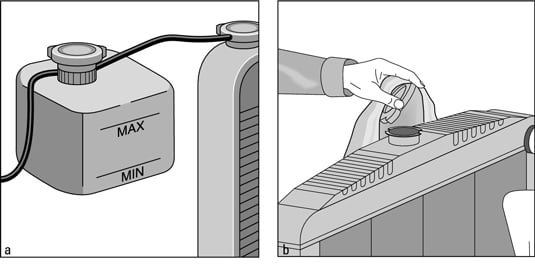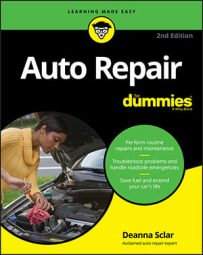If your car has a coolant recovery system, you can check the level of liquid on the side of the plastic reservoir. You just open the cap on the reservoir to check whether the coolant looks as though it needs changing or to add water and coolant.
Many vehicles have a pressurized coolant recovery system called an expansion tank that makes opening the radiator unnecessary. These systems are considered “sealed” because the safety pressure cap is on the recovery reservoir rather than on the radiator.
If you overfill the system, the extra liquid gets hot, expands, and flows out of the overflow pipe. That may not seem too terrible, but because coolant is toxic, it can harm animals or children, who love its sweet taste.
If you don’t have coolant on hand and you just need to add a little liquid to the cooling system, plain old tap water will do. But try to maintain a good coolant level by adding a similar amount of straight coolant the next time you add liquid to the system.
You will probably never need to open the cap on the radiator, but if you have to open the cap for any reason, make sure to fill the radiator to the top with a 50/50 mixture of coolant and water before replacing the cap. This addition bleeds the system by forcing any air that may have gotten into the system into the reservoir and out through its overflow pipe when the engine heats up. Follow these steps when adding liquid to the coolant recovery system:Adding cold liquid to an engine that’s hot can crack the engine block because the hot metal contracts sharply when the cold liquid hits it.
-
Check the liquid level.
Look at the outside of the reservoir to see where the level of the liquid in it lies relative to the “MAX” and “MIN” lines embossed on the side, as shown here.
 A coolant recovery reservoir (a) and a cap being removed safely from a radiator (b).
A coolant recovery reservoir (a) and a cap being removed safely from a radiator (b). -
Lift the lever on the safety cap to allow the pressure to escape.
To keep from burning your hand, place a cloth over the cap after you raise the lever. Then turn the cap counterclockwise to remove it.
-
If the liquid level is low, add equal parts coolant and water to the reservoir.
Add equal parts coolant and water until the level reaches the “MAX” line on the side of the container.

